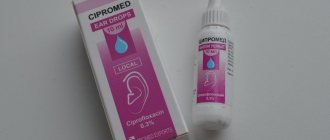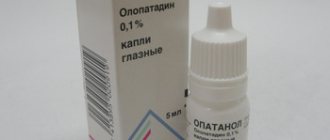Pharmacological properties of the drug Zyprexa tablets
Olanzapine is an antipsychotic drug (neuroleptic) with a wide pharmacological spectrum of action due to its effect on a number of receptor systems. The affinity of olanzapine for serotonin 5-HT2A/C-, 5-HT3-, 5-HT6-, dopamine D1-, D2-, D3-, D4-, D5-, muscarinic M1-, M5-, α1-adrenergic and histamine H1 receptors. During experiments studying the effect of olanzapine on the behavior of animals, the presence of olanzapine antagonism in relation to both serotonin 5-HT and dopamine and cholinergic receptors was revealed. Under in vitro and in vivo , olanzapine has a more pronounced affinity and activity for serotonin 5-HT2 receptors compared to dopamine D2 receptors. According to electrophysiological studies, olanzapine selectively reduces the excitability of mesolimbic (A10) dopaminergic neurons, and at the same time has a slight effect on striatal (A9) nerve pathways involved in the regulation of motor functions. Olanzapine inhibits the conditioned defense reflex, which indicates its antipsychotic activity at lower doses than at doses that cause catalepsy (a disorder reflecting side effects on motor function). Two placebo-controlled and two of three comparative controlled studies involving 2900 patients with schizophrenia showed that olanzapine provided a statistically significant reduction in both productive and negative disorders. Pharmacokinetics. After oral administration, olanzapine is well absorbed and its maximum plasma concentration is reached after 5–8 hours. The absorption of olanzapine does not depend on food intake. In clinical studies examining doses ranging from 1 to 20 mg, olanzapine plasma concentrations were shown to be linear and dose proportional. Olanzapine is metabolized in the liver as a result of conjugation and oxidation processes. The main circulating metabolite is 10-N-glucuronide, which does not cross the BBB. Cytochrome P450 isoenzymes CYP 1A2 and CYP 2D6 are involved in the formation of N-desmethyl and 2-hydroxymethyl metabolites of olanzapine. Both metabolites had significantly less pharmacological activity than olanzapine in vivo The main pharmacological activity of the drug is due to the parent substance - olanzapine. After oral administration, the mean elimination half-life of olanzapine in healthy patients is 33 hours (range 21 to 54 hours for 5 and 95%), and the mean plasma clearance of olanzapine is 26 L/h (range 12 to 47 L/h for 5 and 95). %). The pharmacokinetics of olanzapine varies depending on gender, age and whether the patient smokes. The specified data is summarized in the table:
Patient characteristics | Half-life, h | Clearance of elimination from blood plasma, l/h |
| Non-smoking patients | 38,6 | 18,6 |
| Smoking patients | 30,4 | 27,7 |
| Women | 36,7 | 18,9 |
| Men | 32,3 | 27,3 |
| Patients over 65 years of age | 51,8 | 17,5 |
| Patients under 65 years of age | 33,8 | 18,2 |
Therefore, smoking, gender and age may influence olanzapine clearance and half-life. The degree of influence of these factors is less pronounced than the interindividual differences in these indicators. In patients with minor renal impairment and practically healthy individuals, there is no significant difference between the average values of the half-life and clearance of the drug. About 57% of olanzapine is excreted in the urine, mainly in the form of metabolites. In smokers with mild hepatic impairment, the clearance of olanzapine is lower than in non-smokers without hepatic impairment. At plasma concentrations from 7 to 1000 ng/ml, about 93% of olanzapine is bound to plasma proteins. Olanzapine binds primarily to albumin and α1-acid glycoprotein. There were no differences in the pharmacokinetics of olanzapine due to race. The CYP 2D6 isoform of cytochrome P450 does not affect the metabolism of olanzapine.
Indications for use of Zyprexa tablets
Olanzapine is indicated for the treatment of exacerbations and as maintenance therapy for schizophrenia and other psychoses with severe positive (delusions, hallucinations, thought disorders, hostility and suspiciousness) and/or negative symptoms (for example, flattened affect, emotional and social isolation, poverty of speech). Olanzapine also reduces the severity of secondary mood symptoms commonly associated with schizophrenia and similar disorders. Olanzapine is effective in maintaining clinical improvement with long-term therapy in patients who respond to initial therapy. Olanzapine, as monotherapy or in combination with lithium or valproate, is indicated for the treatment of acute manic or mixed episodes in bipolar disorder, with or without psychotic features, as well as rapid cycling. Olanzapine is indicated to reduce the severity of manic, mixed or depressive episodes in bipolar disorders and prolong the interictal period. Olanzapine in combination with fluoxetine is indicated for the treatment of depressive episodes occurring in bipolar disorder.
Use for liver dysfunction
In the early stages of therapy, taking the drug was accompanied by a transient, asymptomatic increase in the levels of hepatic transaminases (AST and ALT). Particular caution is required when increasing AST and/or ALT levels in patients with impaired liver function, with limited liver functional reserve, or in patients receiving potentially hepatotoxic drugs. If AST and/or ALT levels increase during drug use, careful monitoring of the patient is required and, if necessary, dose reduction.
Use of Zyprexa tablets
Schizophrenia and related disorders: The recommended starting dose of olanzapine is 10 mg once daily with or without food, as absorption of the drug is not affected by food. The dosage range for olanzapine is 5–20 mg per day. The daily dose should be determined based on an assessment of the clinical status. Increasing the recommended starting dose above 10 mg is possible only after a clinical examination. Acute mania in bipolar disorder: The recommended starting dose of olanzapine as monotherapy is 15 mg per day or 10 mg per day in combination with lithium or valproate. This dose is prescribed regardless of food intake, since food intake does not affect the absorption of the drug. The dosage range for olanzapine is 5–20 mg per day. The daily dose should be determined based on an assessment of the clinical status. An increase in the recommended starting dose is possible only after clinical evaluation and should be carried out sequentially at intervals of at least 24 hours. Maintenance therapy for bipolar disorder: In patients who received olanzapine for the treatment of acute mania, maintenance therapy for bipolar disorder should be continued at the same dose. For patients in remission, the recommended starting dose of olanzapine is 10 mg per day. The subsequent daily dose is determined based on clinical status in the range of 5–20 mg per day. Olanzapine is prescribed regardless of food intake, as it does not affect the absorption of the drug. Bipolar depression: Olanzapine in combination with fluoxetine is prescribed once daily with or without food, usually starting with 5 mg olanzapine and 20 mg fluoxetine. The effectiveness of olanzapine as an antidepressant was demonstrated in the dose range of 6–12 mg (mean daily dose 7.4 mg) and fluoxetine 25–50 mg (mean daily dose 39.3 mg) in two clinical studies. Dose adjustment, if necessary, can be carried out for each drug separately (olanzapine, fluoxetine). General data regarding oral use in certain populations: at a reduced initial daily dose of 2.5–5 mg, the drug can be prescribed to elderly patients or in the presence of other clinical factors. An initial dose of 5 mg is recommended in patients with severe renal or moderate hepatic impairment, as well as in patients with a combination of factors (female gender, older age, smoking) that may reduce the metabolism of olanzapine. The effect of olanzapine in patients under 18 years of age has not been studied.
"ZIPREXA": composition
The tablet form of the drug Zyprexa is a balanced composition, which includes:
- active ingredient olanzapine in dosages of 5, 7.5 and 10 milligrams;
- lactose monohydrate;
- crospovidone;
- magnesium stearate;
- hyprolose;
- cellulose.
It is the main component that provides a therapeutic neuroleptic effect on the body; the auxiliary components support the tablet format of the drug, and also facilitate administration and guarantee effective absorption of the components. Sold in metalized blisters of 7 tablets each. Three blisters in individual cardboard packaging. Each Zyprexa box contains instructions for use on paper.
Side effects of Zyprexa tablets
In clinical studies, the most common (≥10 % ) side effects associated with olanzapine were somnolence and weight gain. An increase in plasma prolactin concentrations was observed in 34% of patients taking olanzapine, but the increase was moderate and transient (the final value did not exceed the upper limits of normal and was statistically insignificantly different from that with placebo), and clinical manifestations of hyperprolactinemia (for example, gynecomastia, galactorrhea, enlarged mammary glands) were rarely noted. In most patients, normalization of prolactin levels occurred without discontinuation of the drug. Common (≤10% but ≥1%) adverse effects associated with olanzapine included dizziness, asthenia, akathisia, increased appetite, peripheral edema, orthostatic hypotension, dry mouth, and constipation. Occasionally, a transient asymptomatic increase in the activity of liver transaminases (ALAT and AST) and eosinophils was detected. In clinical studies of patients with a baseline plasma glucose level of ≤140 mg/dL, isolated cases of increased glucose levels of both ≥200 mg/dL (probable diabetes mellitus) and ≥160 mg/dL but ≤200 mg/dL (probable diabetes mellitus) were observed. hyperglycemia). Rarely (≤1% and ≥0.01%) side effects such as photosensitivity and bradycardia were noted. Very rarely (≤0.1%, but ≥0.01%) hepatitis, leukopenia, seizures, skin rash are possible; extremely rare (≤0.01%) - allergic reactions, withdrawal syndrome, venous thromboembolism, jaundice, pancreatitis, thrombocytopenia, diabetic ketoacidosis, diabetic coma, hyperglycemia, hypercholesterolemia, hypertriglyceridemia, rhabdomyolysis, priapism, increased alkaline phosphatase and bilirubin. Adverse effects in selected populations In clinical trials, patients with drug-induced (dopamine agonist) psychosis associated with Parkinson's disease were significantly more likely to experience an increase in symptoms compared to placebo. Hallucinations were also reported very frequently compared to placebo. During clinical trials, the most common (≥10%) adverse effects associated with olanzapine in elderly patients with dementia-associated psychosis were gait disturbance and falls; common (≤10% but ≥1%) are urinary incontinence and pneumonia. Very common (≥10%) side effects in patients with bipolar disorder receiving olanzapine in combination with lithium or valproate were weight gain, dry mouth, increased appetite and tremor, common (10% but ≥1%) were also speech disorders.
Special instructions for the use of Zyprexa tablets
Warning! Neuroleptic malignant syndrome (NMS) NMS, a potentially fatal syndrome complex, has been described with the use of antipsychotic drugs, including olanzapine. Clinical manifestations of NMS include hyperpyrexia, muscle rigidity, loss of consciousness and symptoms of instability of the cardiovascular system (irregular pulse or blood pressure, tachycardia, increased sweating and cardiac arrhythmia). Additional signs may include increased CPK activity, myoglobinuria (rhabdomyolysis), and acute renal failure. Clinical manifestations of NMS, as well as the presence of high fever without other clinical manifestations of NMS, require immediate discontinuation of all antipsychotics, including olanzapine. Tardive dyskinesia Due to the high risk of developing tardive dyskinesia with long-term use of antipsychotic drugs, a concerted dose reduction or complete discontinuation of the drug is necessary if the patient develops signs or symptoms of tardive dyskinesia. Over time, these symptoms may worsen the patient's condition or even appear after treatment is stopped. The effectiveness and safety of olanzapine in elderly patients with psychosis due to dementia have not been established. Risk factors associated with increased mortality in the population of patients receiving olanzapine therapy include age ≥80 years, concomitant use of sedatives, benzodiazepines, or the presence of concomitant pulmonary pathology (for example, pneumonia with or without aspiration). Warning! Liver function indicators. When using olanzapine, transient asymptomatic increases in the activity of hepatic transaminases (ALT and AST) were sometimes noted, especially at the beginning of treatment. In rare cases, the development of hepatitis and very rare cases of cholestatic or mixed liver damage have been reported. If the activity of ALT and/or AST increases during treatment, it is necessary to monitor the patient's condition and consider the advisability of reducing the dose of the drug. Hyperglycemia and diabetes mellitus : There is a high prevalence of diabetes mellitus among patients with schizophrenia. As with other antipsychotic drugs, hyperglycemia, diabetes mellitus, worsening of existing diabetes mellitus, ketoacidosis, and diabetic coma occur very rarely. A cause-and-effect relationship between the use of antipsychotic drugs and the listed conditions has not been established. Appropriate clinical monitoring is recommended in patients with diabetes mellitus and patients with risk factors for developing diabetes mellitus. Seizures Olanzapine should be used with caution in patients with a history of seizures or who are sensitive to factors that lower the seizure threshold. Rare cases of seizures have been reported in such patients during treatment with olanzapine. Anticholinergic activity Clinical studies have demonstrated a low incidence of anticholinergic manifestations. However, clinical experience with olanzapine in patients with concomitant diseases is limited, so caution is recommended when prescribing the drug to patients with clinically significant prostatic hypertrophy, paralytic ileus and angle-closure glaucoma. Dopaminergic Antagonism Olanzapine in vitro and may theoretically antagonize the effects of levodopa and dopamine agonists, as do other antipsychotics. General effect on the central nervous system Given the predominant effect of olanzapine on the central nervous system, care must be taken when prescribing it in combination with other centrally acting drugs and avoid simultaneous use of alcohol. Use during pregnancy and lactation Existing experience with olanzapine treatment during pregnancy is limited; the drug should be prescribed only in cases where the expected benefit of therapy for the mother significantly outweighs the potential risk to the fetus. Isolated cases of tremor, hypertension (arterial hypertension), drowsiness and insomnia have been described in infants whose mothers took olanzapine in the last trimester of pregnancy. In a study of healthy women who were breastfeeding, olanzapine was detected in breast milk. Patients are advised to stop breastfeeding if they are taking olanzapine. Effect on the ability to drive vehicles and operate potentially dangerous machinery Since olanzapine can cause drowsiness and dizziness, patients should avoid potentially hazardous activities during treatment with the drug.
Pregnancy and lactation
If pregnancy occurs or is planned during olanzapine therapy, patients should be advised to consult a physician. Due to the limited use of olanzapine in human pregnancy, the drug should be prescribed during pregnancy only when the potential benefit of therapy to the mother significantly outweighs the potential risk to the fetus.
The study found that olanzapine is excreted in breast milk. Breastfeeding should be discontinued during olanzapine therapy.
Drug interactions Zyprexa tablets
The metabolism of olanzapine may be influenced by inhibitors or inducers of cytochrome P450 isoforms, especially CYP 1A2. Smoking or concomitant administration of carbamazepine increases the clearance of olanzapine. Smoking and treatment with carbamazepine stimulate CYP 1A2 activity. Inhibitors of CYP1A2 activity may reduce the clearance of olanzapine. Olanzapine is a weak inhibitor of CYP1A2 activity; it does not alter the pharmacokinetics of theophylline, which is predominantly metabolized by CYP 1A2. Clinical studies have found that the use of olanzapine during therapy with the following drugs is not accompanied by inhibition of the metabolism of such drugs: imipramine or its metabolite desipramine (CYP 2D6, CYP 3A, CYP 1A2), warfarin (CYP 2C19), theophylline (CYP 1A2), diazepam ( CYP 3A4, CYP 2C19). There was no interaction of olanzapine when administered concomitantly with lithium salts or biperiden. When steady state concentrations were reached, olanzapine did not affect the pharmacokinetics of ethanol. However, when ethanol is used concomitantly with olanzapine, additive pharmacological effects, such as increased sedation, may occur. Single doses of cimetidine or aluminum/magnesium-containing antacids did not affect the oral bioavailability of olanzapine. Additional administration of activated charcoal reduced the oral bioavailability of olanzapine by 50–60%. Fluoxetine (60 mg as a single dose or 60 mg daily for 8 days) resulted in an average increase in the maximum concentration of olanzapine by 16% and an average decrease in olanzapine clearance by 16%. The variation of these factors is small compared to the overall individual variability, so dosage adjustments are usually not required. Fluvoxamine, a CYP1A2 inhibitor, reduces the clearance of olanzapine. This results in an average increase in fluvoxamine Cmax: 54% among non-smoking women and 77% among male smokers. The mean increase in olanzapine AUC was 52% and 108%, respectively. Patients taking fluvoxamine should have their dosage of olanzapine reduced. In vitro experiments with human liver microsomes revealed that olanzapine has a slight ability to suppress the process of glucuronidation of valproic acid (the main route of its metabolization). In addition, a negligible effect of valproate on the metabolism of olanzapine in vitro . Daily additional in vivo of 10 mg olanzapine for 2 weeks did not affect the steady-state plasma concentration of valproate. Therefore, when valproate and olanzapine are used in combination, no additional adjustment of the dose of valproate is required. With a single intramuscular injection of olanzapine at a dose of 5 mg 1 hour before the administration of 2 mg of lorazepam, the pharmacokinetics of these drugs did not change. However, the administration of this combination of drugs was accompanied by increased drowsiness, which is typical when each drug is administered separately. Olanzapine has antagonistic activity against α1-adrenergic receptors. The drug should be prescribed with caution to patients taking antihypertensive drugs. Because olanzapine is metabolized by CYP 1A2, substances that can stimulate or inhibit this isoenzyme may affect the pharmacokinetics of olanzapine.
Pharmacokinetics
Suction
After intramuscular administration, Cmax in plasma is reached within 15-45 minutes. Cmax with intramuscular administration of 5 mg of olanzapine is 5 times higher than the concentration achieved by oral administration of an equivalent dose. In the range of therapeutic doses, pharmacokinetics are linear.
Metabolism
Metabolic characteristics with intramuscular administration are quantitatively and qualitatively similar to the metabolic characteristics of olanzapine after oral administration.
Removal
T1/2 with intramuscular administration is similar to T1/2 observed after oral administration.
Overdose of Zyprexa tablets, symptoms and treatment
Symptoms: very common (≥10%) symptoms of olanzapine overdose are tachycardia, agitation/aggression, dysarthria, various extrapyramidal disorders and disturbances of consciousness of varying severity (from sedation to coma). Other clinically significant effects of olanzapine overdose included delirium, seizures, coma, potential for NMS, respiratory depression, aspiration, hypertension or hypotension, arrhythmias (≤2% of cases), and cardiopulmonary shock. The minimum dose for an acute overdose with a fatal outcome was 450 mg, the maximum for an overdose with a favorable outcome was 1500 mg. Treatment: there is no specific antidote. It is not recommended to prescribe drugs that cause vomiting. Gastric lavage and administration of activated charcoal are indicated (its use reduces the bioavailability of olanzapine when taken orally by 50–60%). Symptomatic treatment is recommended in accordance with the clinical condition and monitoring of vital organ functions, including the elimination of arterial hypotension, circulatory collapse and support of respiratory function. Dopamine, epinephrine and other sympathomimetics, which are β-adrenergic receptor agonists, should not be used, since β-adrenergic stimulation can aggravate the manifestations of arterial hypotension. Cardiac monitoring of the cardiovascular system is necessary for timely detection of possible arrhythmia. Careful medical observation should be carried out until the patient recovers.








